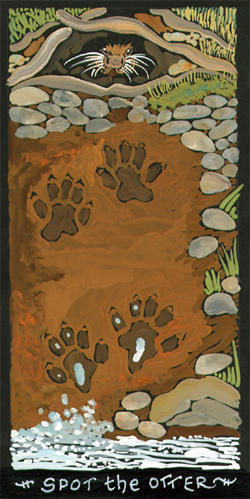As
Bentham lies amongst unspoilt countryside, untouched by Agribusiness,
wildlife thrives here in great variety.

Ancient hedgerows, where gnarled hawthorns grow out
of tumbledown stone walls (these are field boundaries which have
remained unchanged for, quite probably, a thousand years) are
home to shrews, weasels, stoats, hedgehogs, lizards, and slow-worms
living amongst stones and roots; the thickets among branches
provide safe nesting-sites and an abundance of berries in autumn
for numerous species of smaller birds.Badgers and foxes, squirrels,
roe deer and of course rabbits are all around. Keeping still
and quiet increases your chances of encountering some wild creature,
perhaps a hare; the most magical of all animals. Birds that you
may see along the river include dippers, herons, grey wagtails,
coots, goosanders and kingfishers. Up on the moorland, lapwings
and oystercatchers are common and colourful.

Click
this picture to go to a jigsaw puzzle page! |
The number of species is probably
highest close to the river, as many animals and birds depend
on it for their food supply and habitat. Within the river, least
obvious but most vital,
are the many species of tiny creature who live in the "boundary
layer" just above the streambed. A happy afternoon can be
spent, armed with a jamjar and magnifying glass, observing this
miniature world of extraordinary creatures. You may also see
migrating sea-trout battling upstream to spawn, or, in the evenings,
all sorts of bats swooping low over the water hunting for insects.
Dragonflies prefer a sunny afternoon. Otters have been seen.
Tawny and Barn owls
are also a fairly
common sight.
swooshing low
through woodland
or perching
almost invisibly
on branches or fenceposts, waiting
for dusk. Often a
blink is the only
give-away of
their prescence.
|
 To
really see and experience the wildlife of Wenningdale, you need
to get up early, wrap up warm, and come out onto the land before
the busy modern world of Man wakes up. To
really see and experience the wildlife of Wenningdale, you need
to get up early, wrap up warm, and come out onto the land before
the busy modern world of Man wakes up.
The Big Stone is a fine place to sit and listen to the curlews,
who often circle round it at dawn. In the evening, a stream of
rooks may often be seen flying north out of the Trough of Bowland
where they feed by day. Reaching the Big Stone, they divide and
fly on to their roosts in the tall trees down in the valley. |